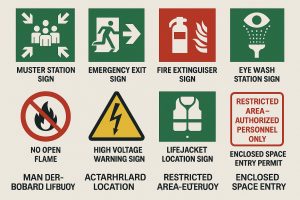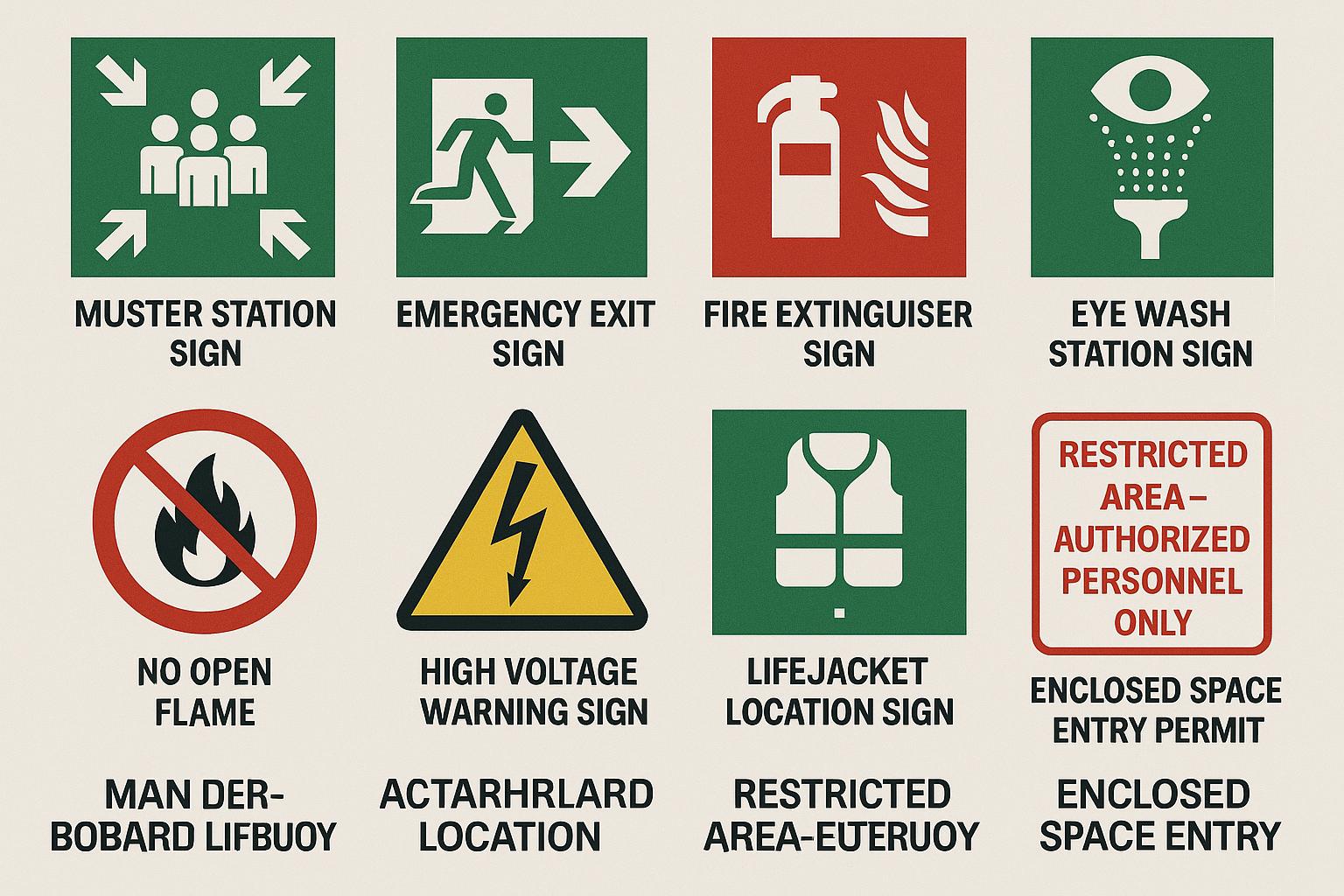Discover the top 10 safety signs every seafarer must understand. Learn how recognizing these symbols can prevent accidents and ensure compliance with maritime safety standards.
Why Safety Signs Matter in Modern Maritime Operations
Life at sea is inherently dangerous. Engine room heat, confined spaces, chemical hazards, and emergency evacuations are just a few of the daily risks faced by seafarers. In such high-stakes environments, clear communication isn’t a luxury—it’s a necessity.
This is where maritime safety signs play a vital role.
According to the International Maritime Organization (IMO) and SOLAS regulations, all vessels must use standardized safety signs to convey critical information quickly and clearly, regardless of language barriers. These signs serve as visual cues for action, warning, mandatory behavior, or location of emergency equipment.
Understanding and reacting appropriately to these signs is not just about passing a safety drill—it’s about surviving real emergencies. This article explores the top 10 safety signs every seafarer must recognize, with examples, visual insights, and real-world relevance.

1. Muster Station Sign
The muster station is the designated assembly area where crew and passengers gather during an emergency. It is a green sign with a symbol of people and arrows pointing inward.
Purpose:
-
Indicates where to report for roll call
-
Central point for donning lifejackets and receiving instructions
Regulatory Reference: IMO Resolution A.760(18) on symbols related to lifesaving appliances and arrangements.
2. Emergency Exit Sign
This green rectangular sign with a figure running through a doorway shows the direction of emergency escape routes.
Key Notes:
-
Should be placed at regular intervals along corridors
-
Must glow in low-light conditions (photoluminescent)
Real-World Importance: During the Norman Atlantic ferry fire in 2014, blocked exits and smoke made visibility difficult. Recognizable signage was vital for crew guidance.
3. Fire Extinguisher Sign
This red square or rectangle includes a pictogram of an extinguisher and often includes the class of fire it addresses (A, B, C, D, or K).
Use:
-
Indicates exact location of fire extinguishing equipment
-
Helps crew choose the right type for electrical, fuel, or metal fires
Compliance: Required under SOLAS Chapter II-2 and IMO ISO 7010 standards.
4. Eye Wash Station Sign
This green and white sign depicts an eye with water spraying toward it. It indicates the presence of an eyewash station near hazardous chemical areas like paint lockers or engine rooms.
Why It Matters:
Chemical splashes or fumes can cause vision loss within minutes if untreated. Crew must locate eyewash stations instantly.
5. No Open Flame Sign
A red circle with a line through a flame—this sign forbids open flames in areas with combustible gases or flammable liquids.
Typical Areas:
-
Fuel bunkering zones
-
Battery rooms
-
Cargo tanks on tankers
Legal Requirement: Mandated by MARPOL and ISGOTT for tankers and chemical carriers.
6. High Voltage Warning Sign
A yellow triangle with a black lightning bolt warns of electrical shock risk in switchboards, motor control centers, and generator rooms.
Action for Cadets:
Only authorized personnel should enter. Always wear PPE and confirm isolation protocols before maintenance.
STCW Training: Covered under marine electrical safety modules (A-III/1 and A-III/6).
7. Lifejacket Location Sign
A green rectangular sign featuring a lifejacket icon identifies where lifejackets are stowed for emergency use.
Must Be:
-
Present in cabins, corridors, and muster stations
-
Accompanied by instructional signs for donning
SOLAS Chapter III mandates clear marking of all lifesaving appliances.
8. Restricted Area – Authorized Personnel Only
This white and red sign limits access to hazardous or sensitive areas such as:
-
Engine control rooms
-
Radio rooms
-
Steering gear compartments
Purpose: Prevents unauthorized or untrained crew from entering areas where specialized procedures are required.
9. Man Overboard Lifebuoy Sign
This green symbol shows a lifebuoy and may include instructions for throwing the buoy and activating attached smoke signals or lights.
Use Case:
These signs are critical on outer decks and should be visible from all directions.
10. Enclosed Space Entry Permit Sign
Often accompanied by a warning triangle, this sign indicates areas that require a Permit to Work (PTW) before entry—e.g., ballast tanks, void spaces, or CO₂ rooms.
Tragic Lesson:
Numerous fatalities have occurred due to improper entry into enclosed spaces, including a 2019 case where three crew members died after entering a non-ventilated cargo tank.
Reference: IMO Resolution A.1050(27) – Recommendations for entering enclosed spaces aboard ships.
–
Real-World Application: Signage Saved a Life in a Fire Drill
During a simulated engine room fire on a container vessel, a cadet took the wrong turn in thick smoke. The ship’s glow-in-the-dark emergency exit signs guided him safely out. He later recalled that without these markers, panic might have led to disorientation or injury. Proper signage is not decorative—it’s directional and potentially lifesaving.
FAQ: Safety Signs on Ships
Q1: Are maritime safety signs standardized globally?
A: Yes. The IMO, in conjunction with ISO 7010 and SOLAS, sets international standards for shapes, colors, and pictograms to ensure universal recognition.
Q2: Are signs required to be multilingual?
A: While pictograms are prioritized, text-based signs should include English, and optionally the working language of the vessel.
Q3: How often should safety signs be inspected?
A: Visual inspections should occur during monthly safety rounds. Signs must be legible, unobstructed, and photoluminescent where required.
Q4: Do cadets need to memorize every safety sign?
A: Yes—especially those related to emergency exits, fire-fighting equipment, and enclosed spaces. These are covered in STCW Basic Safety Training (BST).
Q5: What’s the consequence of missing or damaged signs during inspection?
A: Port State Control or internal audits can cite deficiencies. Repeat offenses may lead to detentions or fines.
Conclusion
Safety signs are more than compliance tools—they are critical anchors in maritime situational awareness. In emergencies where seconds count and communication may fail, a clearly marked exit or lifebuoy can spell the difference between survival and tragedy.
For seafarers, particularly new cadets, learning to read and respond to these symbols is as essential as understanding navigational charts or engine schematics. These top 10 safety signs form the visual language of onboard safety—and fluency is mandatory.
Call to Action: Want to test your knowledge? Download our Free Safety Sign Flashcard Set and challenge your crew today.
References
-
International Maritime Organization. (2023). SOLAS Consolidated Edition. https://www.imo.org
-
ISO. (2023). ISO 7010: Graphical symbols — Safety colours and safety signs. https://www.iso.org
-
ICS. (2022). Maritime Safety Guide for Shipboard Personnel. https://www.ics-shipping.org
-
BIMCO. (2022). Best Practices in Safety Sign Management Onboard Ships. https://www.bimco.org

